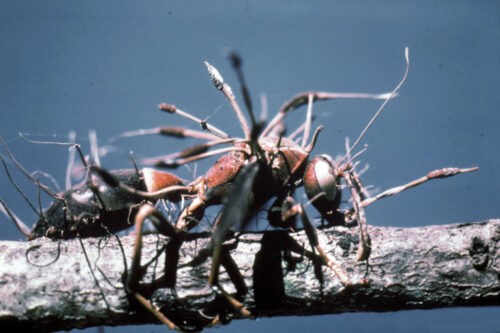Before the release of The Last of Us, most people had probably never heard of the fungus Cordyceps. In the tv show and the video game, Cordyceps takes control of people, turning them into zombies that spread the infection. In the real world, Cordyceps doesn’t infect humans, but it does infect ants, taking control of their minds and using them to spread the infection to their colony-mates. Cordyceps is part of a large group known as entomopathogenic fungi, fungi that infect and seriously harm or kill insects.
Entomopathogenic fungi are found in several distinct lineages within the fungi (and in the Oomycetes, a group of organisms that were formerly included in the fungal kingdom). They have a range of life cycles, but typically use enzymes to bore a hole in the insect’s exoskeleton and infect the host. They can be useful in the biological control of certain insect pests, and some species are also useful in bioremediation, because they can produce enzymes able to break down certain harmful synthetic compounds.

Although the Wikipedia article on entomopathogenic fungi has existed since 2006, the article remained fairly short and undeveloped until the Fall 2024 term when a student in Kasey Fowler-Finn’s Advanced Evolution class started working to expand the article.
The student editor reworked the article from top to bottom, more than tripling its size and adding 29 new references to the scholarly literature. The article now does a much better job of capturing the diversity of life cycles exhibited by entomopathogenic fungi, and includes details about the many different phyla of fungi that exhibit this type of activity.
In addition to this, they also added a section about the evolutionary history of entomopathogenicity, noting that the ability to infect insects had evolved many times in different fungal lineages. The ability to infect insects has also been lost many times across different lineages, creating an even more complicated picture.
And importantly for people who don’t love fungi for their own sake, the article now includes information of their use in the biological control of several insect pests, and their use in bioremediation.
When you edit an article on Wikipedia, you’re adding to the knowledge that’s accessible to the public at large. Will an expanded article about entomopathogenic fungi change the world? Maybe. Perhaps someone will stumble upon it and it will pique their interest in a new field and they will discover a new way to break down toxic chemicals. Or someone will read it and make some new connections about something in their own field. Or maybe someone will find “entomopathogenic” to be a fascinating word that draws their interest toward linguistics.
There’s no guarantee that expanding a Wikipedia article will change the world, but there’s always a chance you’ll change someone’s world. After all, even an article about a topic as obscure as this one has received over 9,000 page views since a student editor started working on it.
Our support for STEM classes like Kasey Fowler-Finn’s is available thanks to the Guru Krupa Foundation.
Interested in incorporating a Wikipedia assignment into your course? Visit teach.wikiedu.org to learn more about the free resources, digital tools, and staff support that Wiki Education offers to postsecondary instructors in the United States and Canada.
